The Broke Backpacker is supported by you. Clicking through our links may earn us a small affiliate commission, and that's what allows us to keep producing free content 🙂 Learn more.
I’ll be honest: when my best mate Jack asked me to join him for a backpacking trip in Sri Lanka in January, I jumped on Google images and searched, “Sri Lankan Mountains” before replying to him.
Adam’s Peak sunrise hike or Ella Rock seemed the two most popular activities in Sri Lanka for people seeking altitude. But I wasn’t chasing the “must do’s or the most popular places to visit in Sri Lanka.” I needed something unique, an adventure unlike any other.
Amongst the pictures, one single photo of a steep, lonely peak caught my eye. It went by the name of Lakegala Peak, smack bang in the guts of the Knuckles Forest Reserve.

Photo: @themanwiththetinyguitar
The Broke Backpacker is supported by you. Clicking through our links may earn us a small affiliate commission, and that's what allows us to keep producing free content 🙂 Learn more.
As I investigated, I found that this mountain is regarded as one of the hardest to access peaks in Sri Lanka with a village in its shadow called Meemure. The more I read, the closer I got to the top of that mountain.
“Off the grid.”
“Sri Lanka’s hardest rock climb.”
“Danger.”
It sounded like my kind of adventure. I quickly replied to Jack and said I would join him under one condition, that we begin our Sri Lankan journey with a quick stop off in the jungle for a climb up Lakegala Peak. Done deal, we were going on a Meemure trip to climb Sri Lanka’s most dangerous mountain.
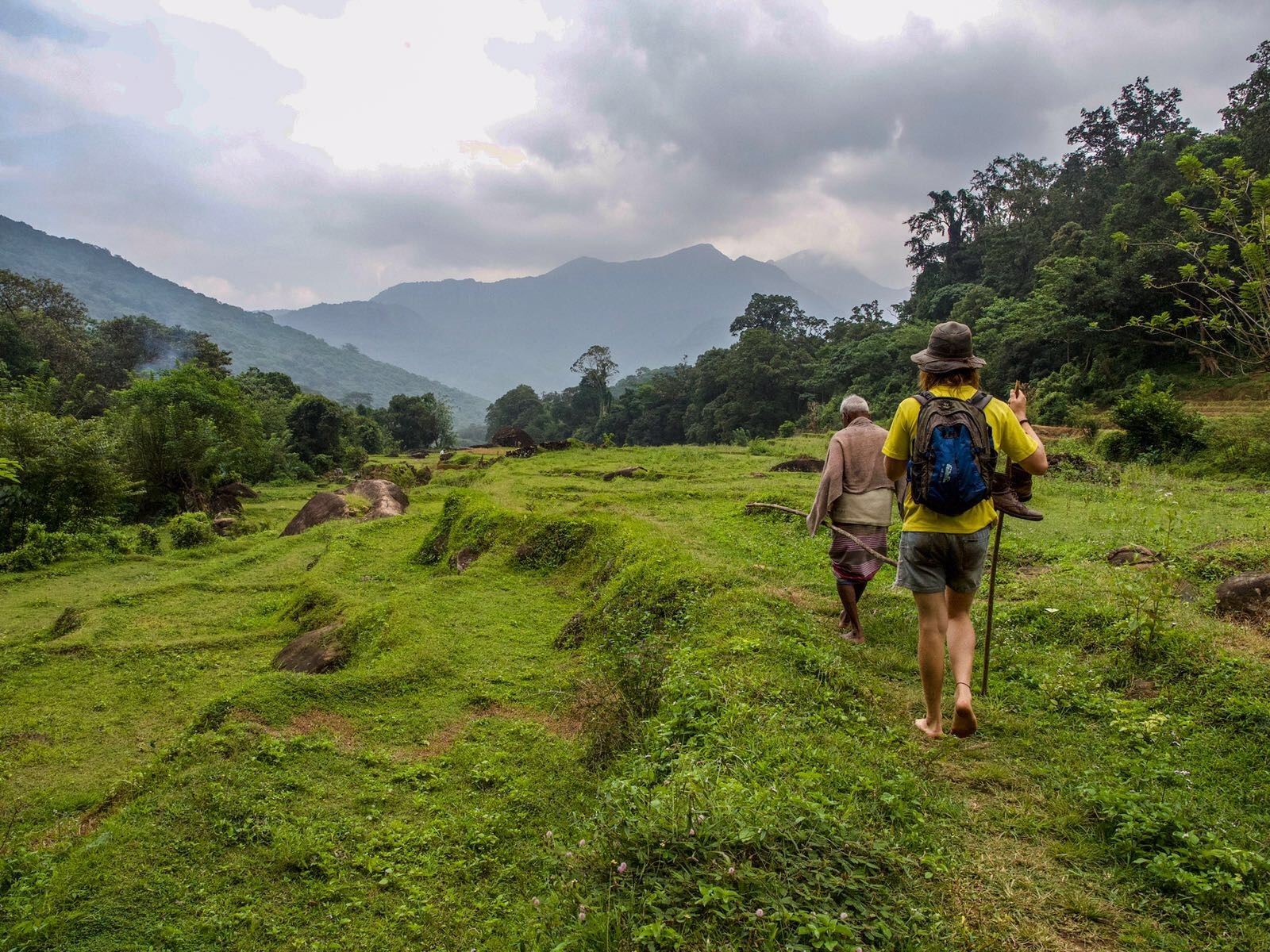
Getting to Meemure Village in Sri Lanka
Through Kandy, it was impossible to find a system of shared public transport to Meemure Village. Even the local people were confused upon our questions of how to get there, and the few that knew gave us looks of disapproval.
The term ‘not recommended’ did get thrown around a bit regarding our trip to Meemure.
Traveling around Sri Lanka?!
Check out our Sri Lanka Epic Hostel Guide for where to stay in this beautiful country!
Our Bed and Breakfast host was able to find us a tuk-tuk driver who was willing to drive us there after some serious bartering, David – what a legend.
(Meemure camping is also a popular option for accommodation, as there aren’t many Meemure Sri Lanka hotels.)
For 6 hours we sat bouncing around in the back of his new tuk-tuk, often having to hop out and give it a push or move obstacles out of the way as we motored up the steep windy mountain roads.
I think our moral support gave us the horsepower we needed. I remember asking him as we approached the village if there was anything dangerous we had to look out for in the jungle here. He replied, “no, no, maybe monkey take your things, it’s ok here.”
That was the least of my worries anyway, as we lay eyes on Lakegala for the first time, my mind began to race with stories I had read about climbers falling off the peak to their death.
This is natural though, a good indication that my brain was doing what it’s supposed to; fear.
When we arrived in Meemure, David translated for us and found us a home we could stay in for a few nights. An old Mama, Papa, and his three sons had a house in the village. Mama lived in the kitchen – literally, she had a bed there – and spent all day and night doing kitchen things.
Papa, for 84, was in decent physical shape. We spent that afternoon with him, as he showed us his land in the surrounding jungle. He would stop and stare at the many trees we passed and mutter words in the local tongue whilst smiling – a deep, timeless connection he had with this place.
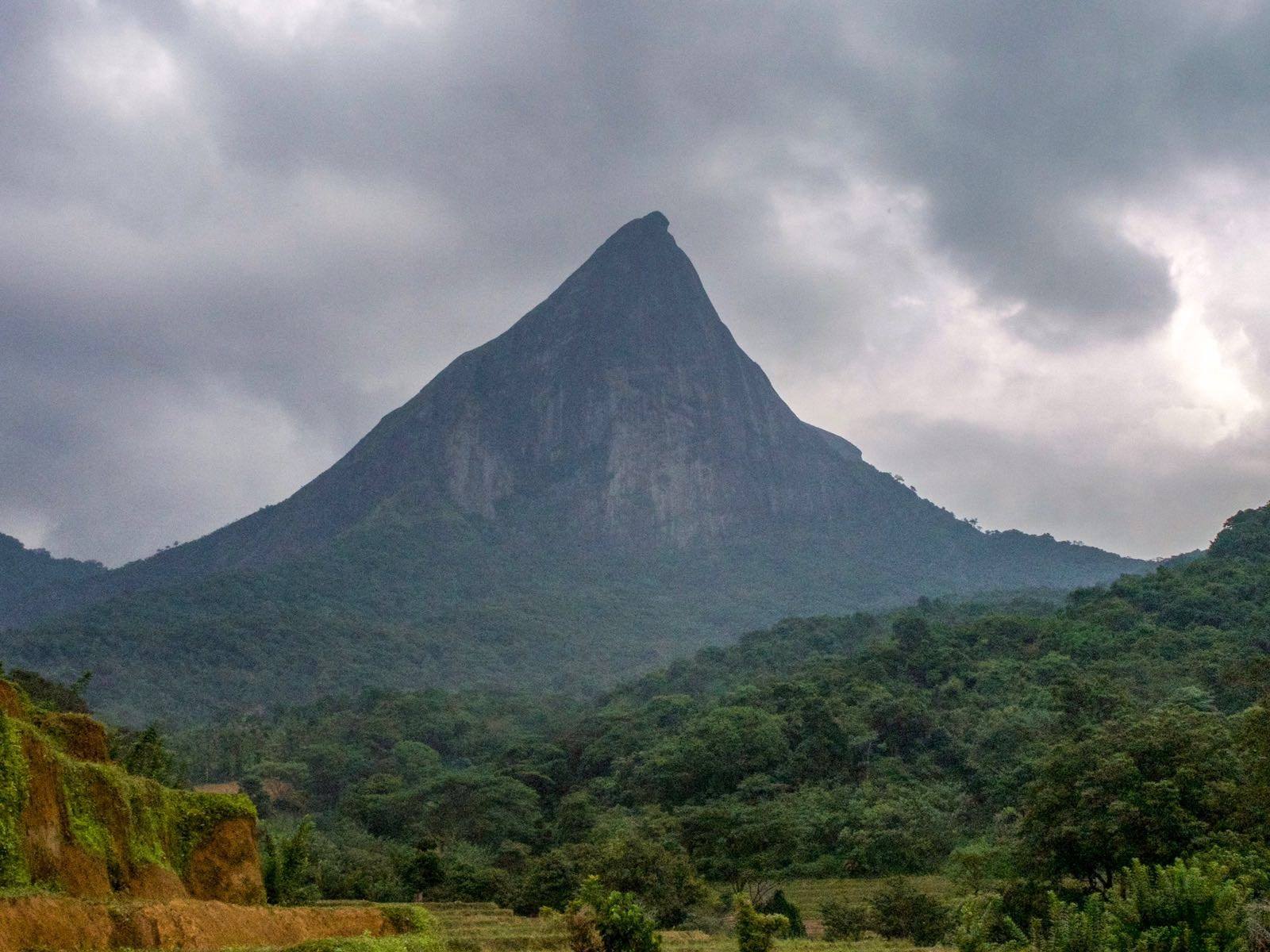
We met a man in the village who spoke basic English, Sunil, and we told him our plans to climb Lakegala. He ended up agreeing to be our guide up the mountain, and to meet him the next morning, ready to climb. Finding a guide was a lot easier than we thought it was going to be.
That night, Mama made up some beautiful Sri Lankan food, sambals and curries with all the ingredients from the garden. Nothing better.
I began to discuss my thoughts with Jack. He had not climbed any serious mountains before, and I could tell he was second questioning the mountain, which was not a good thing.
I made him promise that if he felt uncomfortable with the climb or his ability at any stage he would stop in his tracks immediately. Jack being the more grounded half of our friendship didn’t need to be told this. Instead, he tried to fire my words back on myself, but I had already decided I was getting to the top.
Beginning the Ascent of Lakegala Peak
We met Sunil at 7 AM in the village. It was an overcast, misty day, where nature brings out its more mysterious, darkly illuminated colours.
We expected him to have some climbing gear, the basics, even a bit of rope, but no: he just had a machete and gama balla, which means “village dog” in Sinhala. Our thoughts were surely he does this often, and maybe he has a little chest in the jungle with all the gear.
He took us to the shrine of the mountain, where he prayed. The mountain is sacred to the people of the village and is not usually something they do for leisure. Jack and I out of respect individually stood at the shrine in silence with our eyes closed. I instantly felt like I was undertaking a ritual that many had undertaken before me, and that some of these people who had been at this exact shrine had not come back off the mountain.
The climb began with a couple of kilometers of trekking through the jungle; this was unreal.
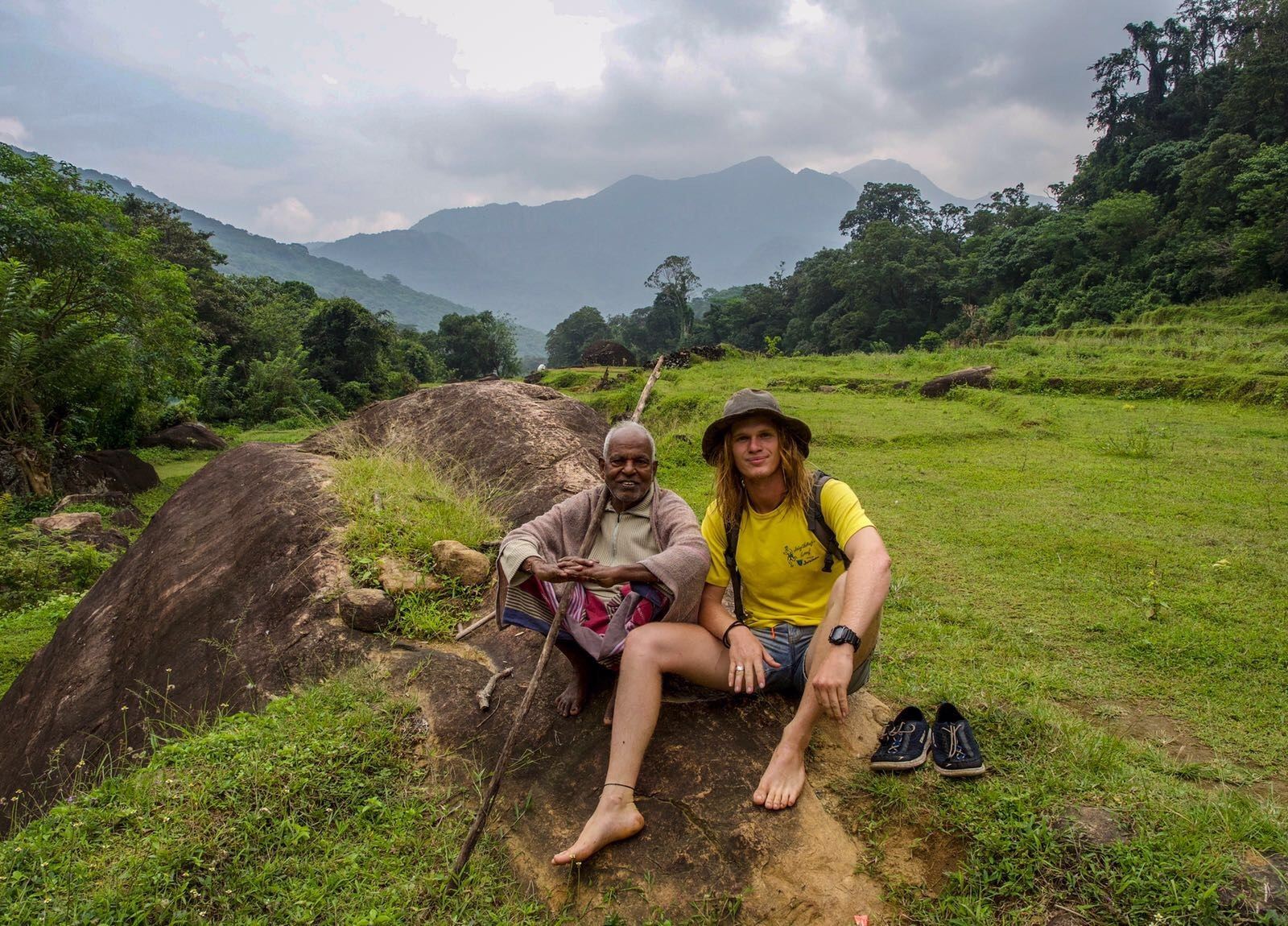
(An interesting thought I have about the Sri Lankan Jungle is that the monkeys have removed all the dead vines and branches. Every single part of a tree is strong and trustworthy, and you can almost walk the jungle via the treetops.)
We traced up to a beautiful stream, eyeing off some waterfalls to stop at on the way back. Monkeys, Birds, Buffalo; all things were here this day. It was clear that this trail was not walked often, the machete was being put to very good use. It was also one of those humid, tropical days, and packing an extra few Litres of water was up there as the best decision of the day.
As we got to the bottom of the peak, we stopped at a waterfall for a swim. It was then that I realised that Sunil still hadn’t stopped to pick up any climbing gear. I was slightly worried as I had read online off various sources to not do the peak without it.
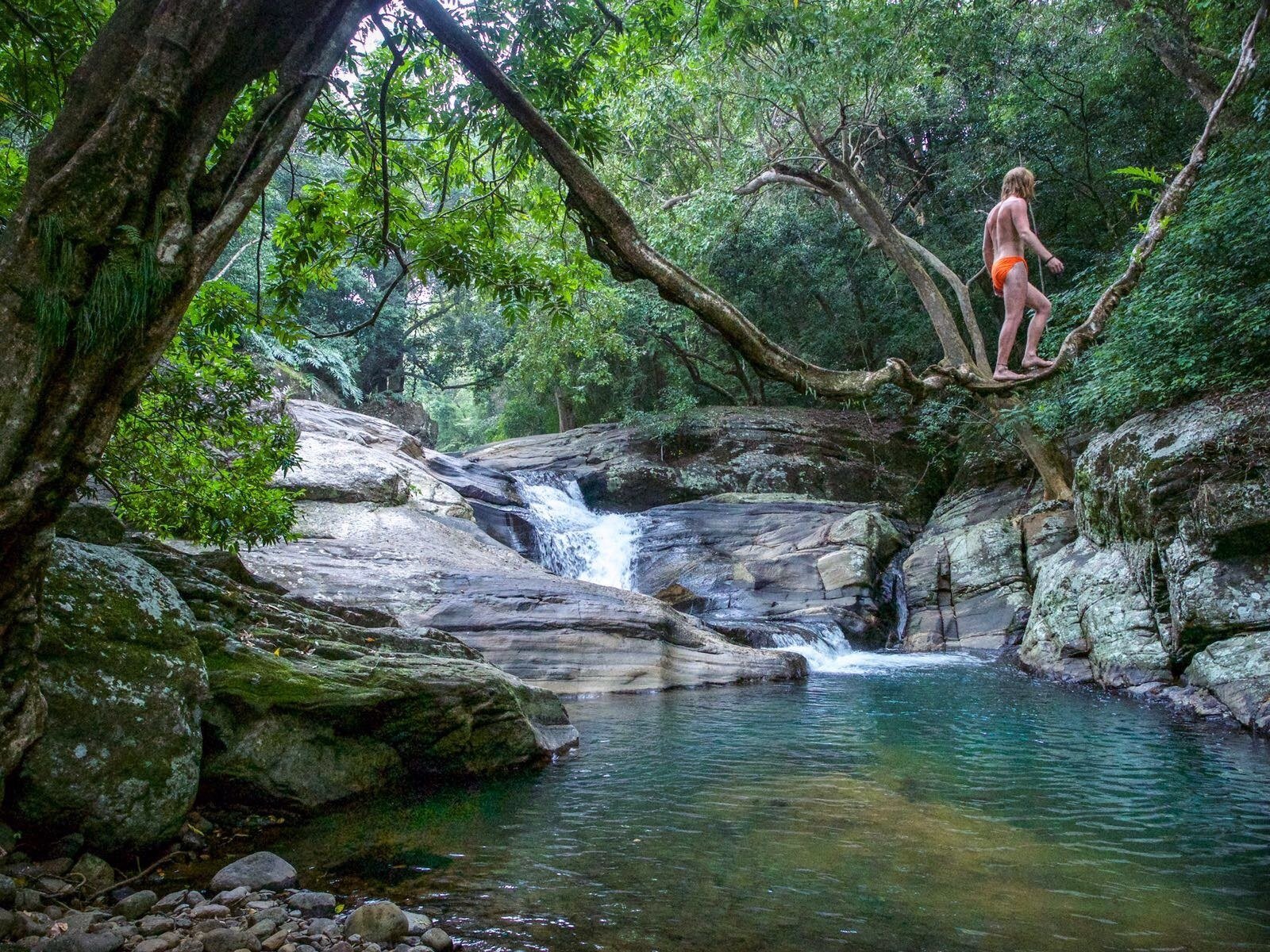
Adventures get Real when You are No Longer the Apex Predator
The first section of the climb was tearing through thick shrubbery: the thorny type. Nothing a couple of young fellas from the Tropics of Australia aren’t used to. It was a lot of dodging and weaving, squatting and jumping, and a few apologies while holding a branch back for one person and releasing it onto the next one’s face.
We like to call it a classic bush bash. Gama Bulla, the dog, was handling it a lot better than us. We were drenched in sweat and getting shredded by the trees, but it didn’t stop us from howling and screaming. It was a real adventure.
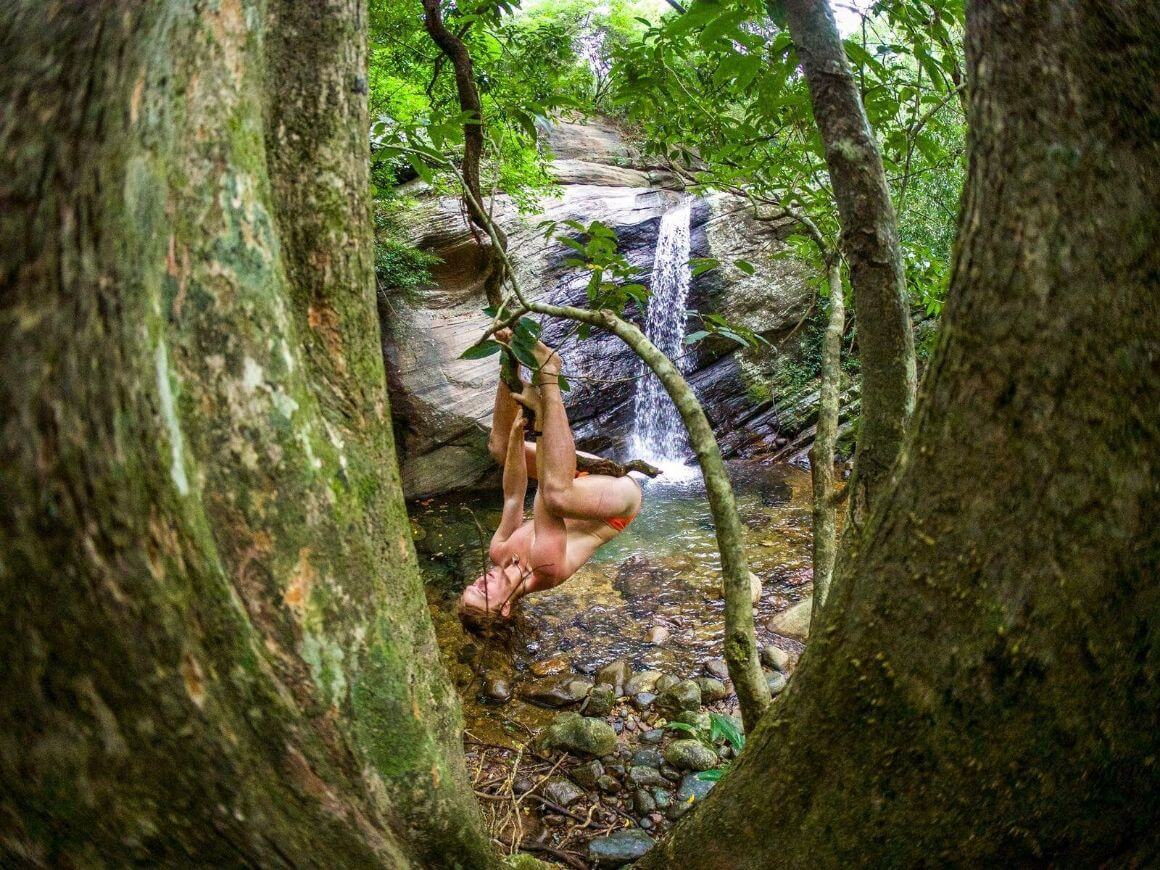
As we came to a little clearing, we found mutilated pieces of a deer carcass, which stopped us dead in our tracks. As Jack and I looked at each other confused, Sunil became uneasy. He began to make eye contact with all our surroundings as if he were looking for something.
“What killed this, Sunil?” What lives on the mountain?” We asked him, he gave us mutters back, saying it could have been anything. He told us than to stop making noise and to move on quietly. We began scrambling up the mountain again. A couple of minutes later, Sunil squatted down and pointed to the ground, where a large, fresh pile of droppings from an animal lay on the soil. Less than a foot away from it, a giant cat print.
We instantly knew what that was from. Sunil looked at us and said, “Look, leopard, leopard!” This was a little bit much for us, as our fears for the day revolved around falling to our death, not getting eaten by a large cat.
Instantly, our fight and flight system kicked in; we were present and on edge. Sunil stood up, and rather calmly said, “It’s okay. Leopard go forest daytime,” as he looked back down the mountain and points into the jungle we had just emerged from.
So many different thoughts were going through our heads.
Jack made a comment about how there is something incredible about being in an environment where you are no longer the apex predator when you are no longer hunting when something could be hunting you. When Sunil pushed Gama Balla back behind us, it was clear that it was the sacrificial dog, not just coming along for the fun.
We decided to keep moving forward, walking very close together, Jack and I competed for a spot in the middle, him making comments like, “at least it’s already eaten,” or “Leopards don’t attack head on, they’ll creep up behind and get your jugular.”
I wasn’t worried about being stalked by a leopard at that moment, but if something went wrong on the mountain, there would be no evacuation – no signal, no helicopter, no rescue squad. It would be one person stuck on the mountain in the dark with the leopard, or one person by themselves going through the jungle to get help.
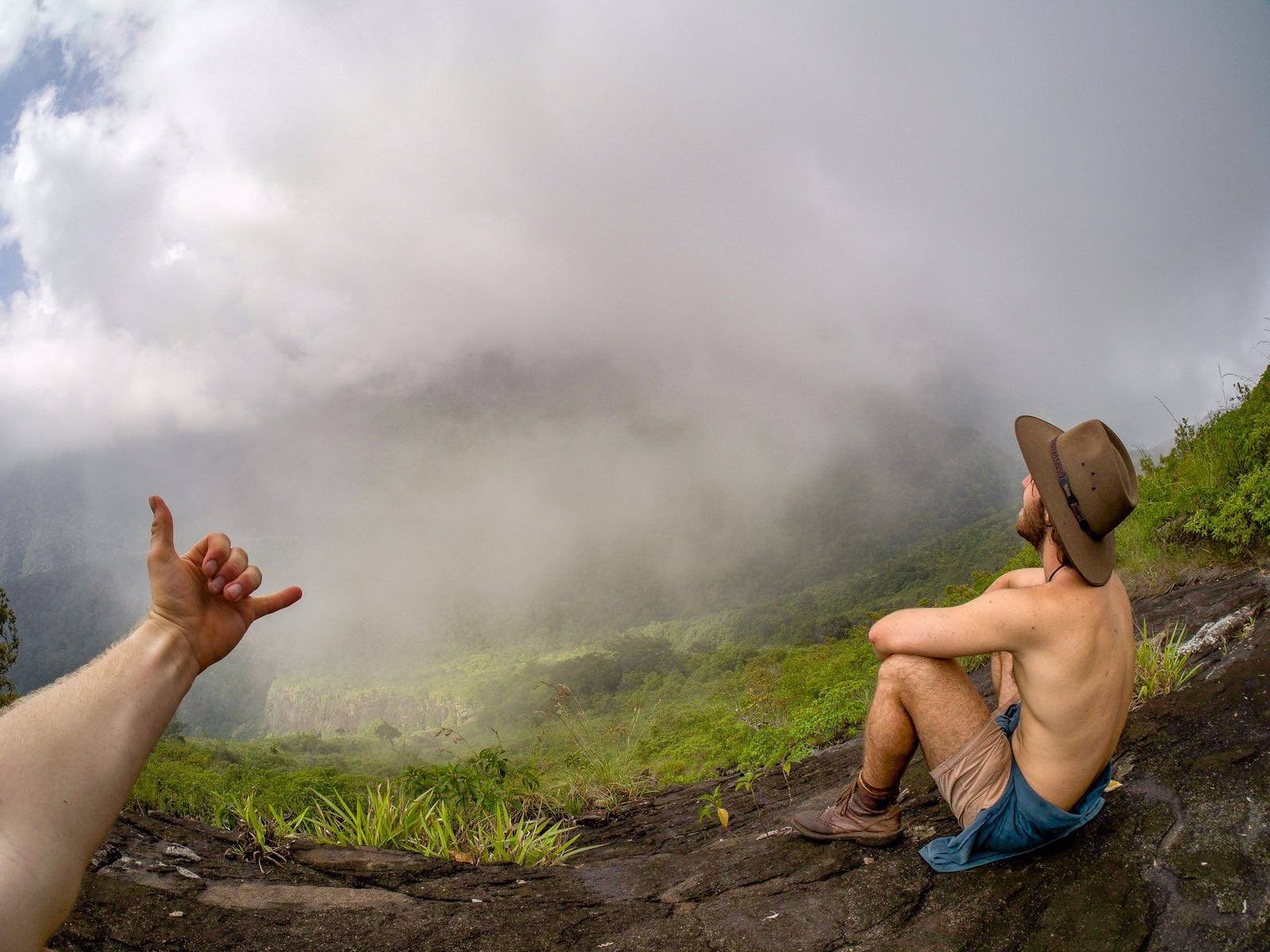
A Large Verticle Crack Climb up Lakegura
As we scrambled up, I began to notice that we hadn’t really been chopping away at any of the trees from the naval down. This was because we were following trails of something this tall, only having to cut the top parts of the short scrub down. We were following leopard trails to the top of Lakegala.
We were silently moving forward, occasionally coming to clearings where we could see the misty mountains that surrounded us. We were in such a breathtaking place. The climb became steeper, and the thick foliage turned into bare, dark rock. We got to the point where we had to leave our boots, water, shirts, and packs behind.
It hadn’t been raining, but the dense cold clouds had created large patches of moisture on the whole face. If one were to slip, it would be a hundred-meter tumble into the thorny scrub, if you were lucky, or a tumble off of a very high cliff if not so lucky.
We came to a point where a large vertical crack ran up the middle of the face; this was the only way up.
You did not want to fall from this cliff. We couldn’t see how high the climb went, or how difficult it became. Jack came through with his promise and agreed to stay at the bottom of the cliff and wait.
I was so glad; neither of us could afford to be doing anything except giving our full attention to the climb. We left him here with the machete and Gama Balla, I remember looking him in the eye and telling him I’d see him soon.
We asked Sunil, who had happened to live in Meemure his whole life of thirty-eight years, how many times he had done Lakegala. He said five. Two of which were summits. He kept asking if I wanted to turn around. I could tell he was nervous and wasn’t comfortable climbing to the top.
I took everything I had off of me, except some denim stubbies Jack’s grandma had given to me, and Sunil and I set off up the crack.

Dancing with the Rock
There was an old rope draped down from the top of the climb to my right-hand side. However, I had made a deal with myself not to use this old, tattered, fixed rope after reading a story of a Columbian climber who had died two years previously when this rope snapped and he tumbled and fell a kilometer to his death.
The rock itself was not very trustworthy. I was having to test it for hollowness, find small pinches for my hands, and constantly wedging my feet in between wet rocks as my anchoring. Every single skill I had attributed in my life – growing up in the rainforests of North East Australia, spending months climbing in the Swiss Alps, building mental strength and becoming present at Yoga centers in India – everything, was being put into use.
I forgot Sunil was with me. The rock and I were dancing; I was feeling where it was telling me to go, stopping in my tracks and withdrawing when I began to make a wrong move. Essentially, I was merging all of my trust between myself and this cliff. I was free climbing.

How long we were on that crack, I don’t know, but when we got past it, it wasn’t over. At the top, the angle of the rock dropped slightly, though we had to traverse sideways along a wet, steep slab of rock to reach the short trek to the summit.
We couldn’t see more than fifteen meters in front of us because the clouds were so thick. As the rock was so slippery, we had to wedge our feet on the roots of grass clusters sprouting out of the rocks, and our hands were gripping big bundles of grass as if they were some sort of rope.
To make it worse, Sunil didn’t know where he was going. He changed course four times and kept asking if I wanted to turn around. It got to the point where I took the lead.
There was one moment where I froze with fear and couldn’t bring myself to step across a large, drenched pitch of rock, with a kilometer drop meters down from it. It’s moments like these when the best things to do is just step back to a comfortable position, close your eyes and breathe.
We eventually got past the danger zone and into some thick jungle with lots of places to ground ourselves. As we got past the short patch of jungle, I spotted a torn, white flag blowing in the wind. We had reached the summit.

In my before-climb head, we were going to be engulfed by the all the Knuckles Mountains, surrounded by clear blue skies, and looking at a beautiful view down a vertical cliff into a village.
Instead, mother nature gave us something much more appropriate to the current situation. I couldn’t see a thing; a howling, cold wind was blowing, and dark grey clouds were rushing up the cliff towards us, but it was in this moment I found peace.
Something mountains may teach you: it wasn’t about the end result, the view at the top, or the shallowly spoken words someone always speaks to try to express a place’s beauty. I had come to somewhere I felt called to with fear that tried to turn me away at every corner, and conquered it.
This was very special to me, and I was overflowing with gratitude. The clouds, the dark jungle, and the danger, whether that be the water, the cliffs, or the leopard, was beautiful, perfect, and just how it should be.
It was all a reflection of me and how I was feeling, and I wouldn’t have wanted to change a thing. It was the journey to the top of this peak that I will remember, not the view.
Same goes for everything in life.
Sunil and I embraced each other, expressing our love for that moment in silence when all I wanted to do was howl and scream, but of course, keeping in mind there was still a leopard un-accounted for.
Don’t forget to pack a good book! Lonely Planet Sri Lanka (Travel Guide) is our top recommendation for an awesome and inspiring read on this magical city.
The Descent Down Lakegala and Back to Meemure
We didn’t want to leave Jack at the base of the cliff for too long, so after a short while at the peak, we began to make our descent. We had to switch back into our state of presentness, aware of everything once again, carefully retracing our path, step for step.
While rock climbing, usually, you have a partner belaying you, lowering you back down to safety, and one thing I had never done, was free climb down a cliff. This was the most mentally and physically challenging part of the day.
Not being able to see where or what you are putting your feet into while having to hold your body weight with something that you are not sure is stable, all while scaling down a cliff. It was a completely new thing for me and was very confronting.
There were a few times I thought I was going to slip and fall or not be able to hold my body weight long enough to find more holds, but it worked out perfectly.
I remember as we got back to the bottom of the crack, I was agitated looking for Jack, I spotted him as he poked his head out from a bush on a cliff. I was so glad he was alright, but his first words were, “guys Gama Balla ran off like half an hour ago,” which was sad because I don’t think anyone ever saw him again. Though honestly, at that point in time, I felt unstoppable and no leopard was going to ruin my day.
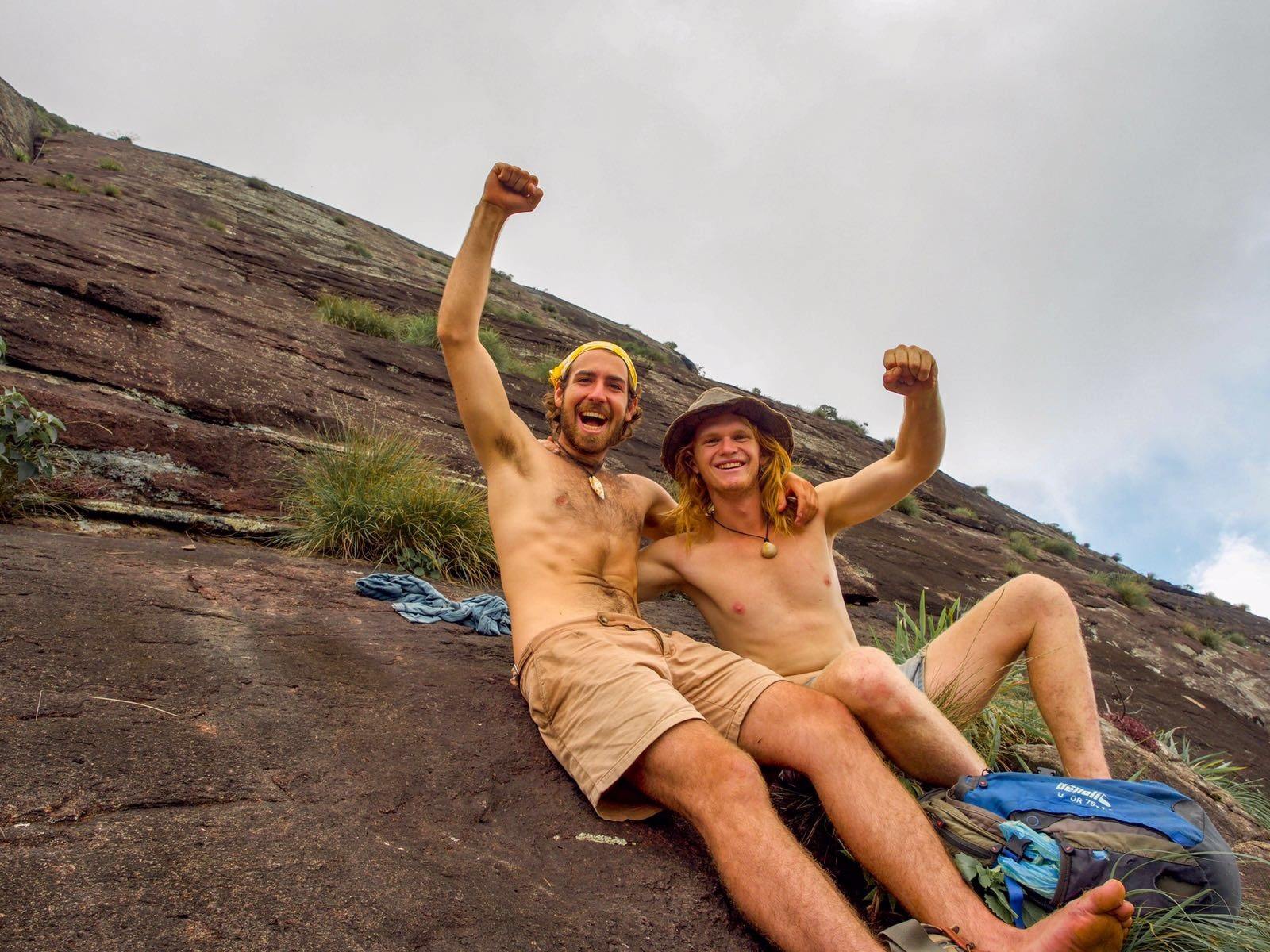
The descent was just as difficult as the ascent. It was slippery and our legs were jelly. We had finished all our water and we wanted to get off the mountain as soon as possible. Step by step we tripped and stumbled while trying not to make a sound and we got back to the base of the mountain and into the jungle.
We went straight to the creek and started to follow that down, going to some of the incredible waterfalls we had spotted on the journey there. We thanked Sunil, gave him some money and made our way back to the house for some food and a nap.
Such a joke: there was no way we were sleeping any time soon.
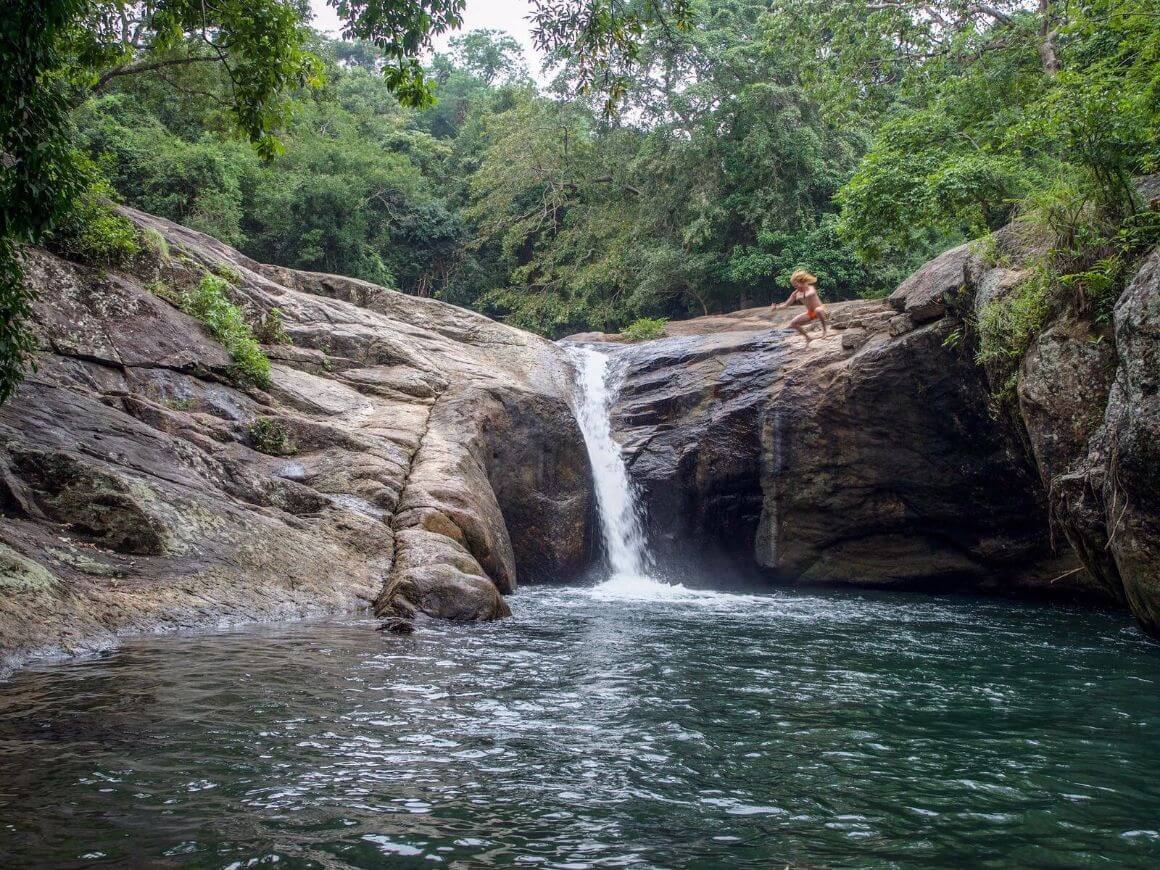
Buy Us a Coffee!
A couple of you lovely readers suggested we set up a tip jar for direct support as an alternative to booking through our links, since we’ve decided to keep the site ad-free. So here it is!
You can now buy The Broke Backpacker a coffee. If you like and use our content to plan your trips, it’s a much appreciated way to show appreciation 🙂
Who is Jack!?
Hey, I’m Jack, 21 years old from tropical Far North Queensland, Australia.
For the last few years, I have been exploring this world, inner and outer. Finding the balance between chasing my dreams and enjoying the flow that life brings.
What I’ve found is that no matter where you go and what you do, you already have what you’re after inside of you, start everything feeling and knowing that.
You can follow his adventures on his Instagram: @fulltimegoodness








